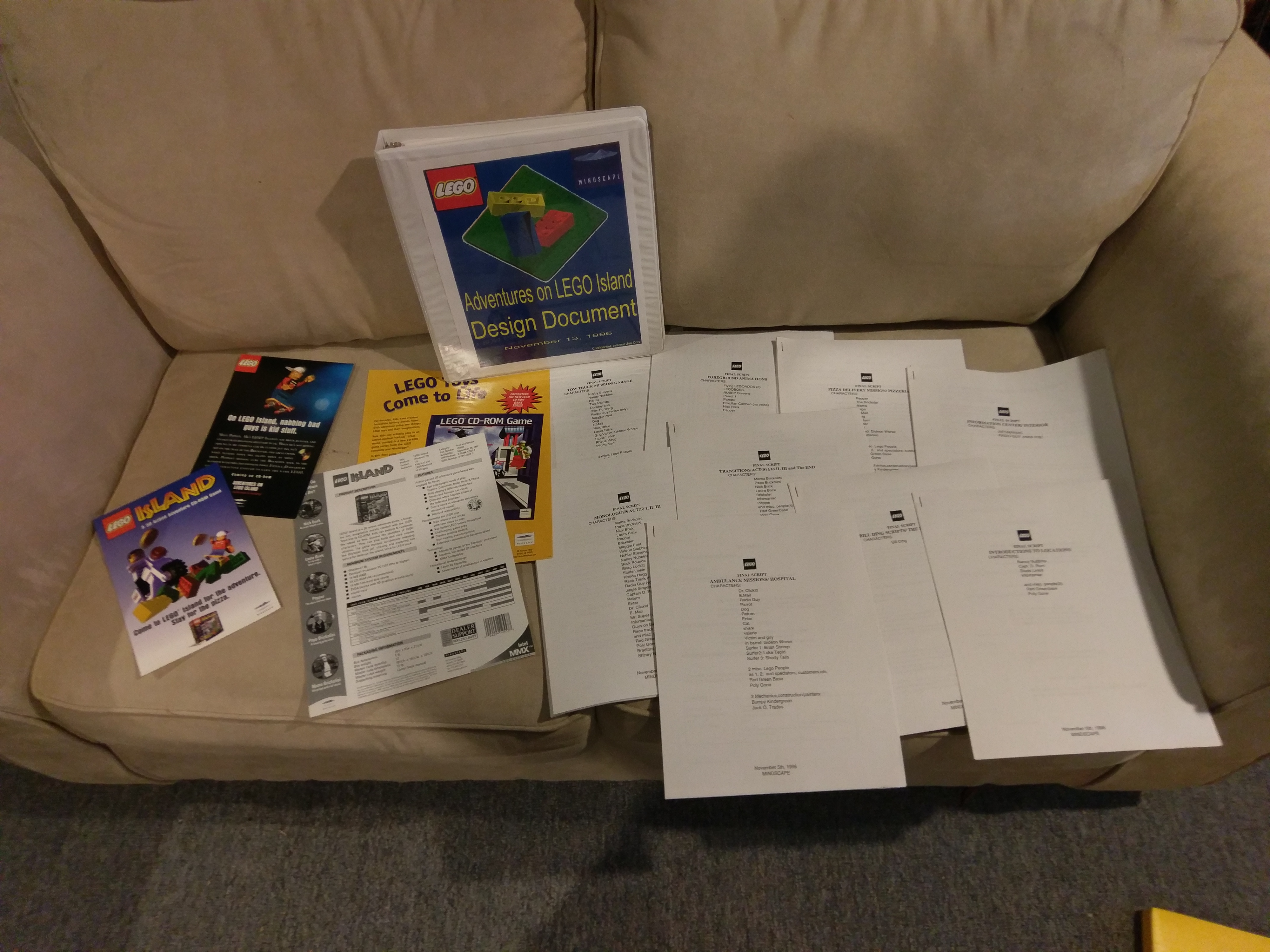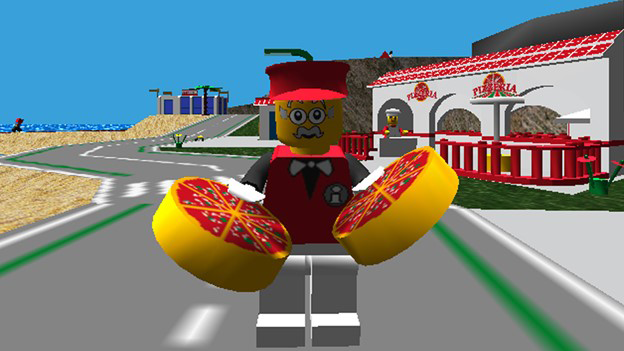LEGO Island: Birth of a LEGO Video Game
December 30, 2020It may not have been the first LEGO® video game, but it was arguably the most impactful.
LEGO Island released in September 1997 to overwhelmingly positive reviews. The open-world LEGO game went on to become a best seller two years in a row and planted the roots for what would become the most successful approach to both the looks of digital LEGO bricks and the philosophical approach to digital play with those toys.
The game’s timing couldn’t have been better.
Game Crash and Nintendo Fear
To fully understand how and why the LEGO Group greenlit the creation of LEGO Island, you need to go back to the infamous video game crash of 1983. Video game revenue peaked that year, but a combination of over investment and poor control of physical stock led to a drop of nearly 97 percent in revenue by 1985. The collapse bankrupted a slew of video game companies and nearly destroyed the once-booming video game industry.
In 1986, Nintendo managed to revive the industry by sneaking its Nintendo Entertainment System console into toy stores. It did this by packaging the system with a plastic robot and marketing it more as a toy than a video game console. The NES’s tremendous success reinvigorated the market, and then the arrival of the Game Boy portable system in 1989 expanded that market. Over the next half-decade, the number of companies reentering the game industry began to blossom. By 1995, the arrival of the fifth generation of consoles included massive players like Sony and its PlayStation. The computer gaming market is also taking off with massive hits like Warcraft, SimCity, and explorative puzzler game Myst.
Amid this second wave of video game growth, California-based software company Mindscape began exploring ways to expand its video game business. The studio started looking into toy companies and decided that pitching a game to the LEGO Group would be a great idea.

Wes Jenkins, who would become LEGO Island’s creative director, and Paul Melmed, who would become the game’s education and research director, traveled to New York City to pitch the idea to the LEGO Group at the annual Toy Fair in February 1995.
The pitch came as the LEGO Group was starting to worry about the impact Nintendo and video games were having on the toy business. The company feared that video games were taking up an increasingly large amount of a child’s free time.
That fall, the LEGO Group leadership asked Tormod Askildsen to explore the impact of video games and whether the LEGO Group should invest in the new medium. In December 1995, Askildsen presented their findings. Most important among them was a single stark statement: Getting into the game industry wasn’t an option; it was a necessity. A month later, the LEGO Group announced a deal with Mindscape for the developer to make a series of video games, the first one based on the LEGO Town theme.
The Making of LEGO Island
The development of the game ended up taking nearly two more years but involved several interesting creative approaches. Among them was the decision to build a full-scale version of the game’s titular LEGO Island with real LEGO bricks and then invite children to come and play with it. By watching what the kids did, the developers were able to hone in on the sorts of play that would be most interesting.
The team also spent quite a bit of time examining and debating the philosophical nature of digital play and how LEGO toys fit into a video game, both in its representation and interactions.
As the team grew to more than 100, work was poured into several aspects of the game, including the ability to play as many different characters, each designed to represent different forms of intelligence, as described by Dr. Howard Gardner’s multiple intelligence theory.
The team also worked to build its own game engine for LEGO Island, with the expectation that the new engine would be used for several sequels to LEGO Island.
As development steadily marched toward launch, the Mindscape team regularly checked in with both the newly formed LEGO Media International and a group of researchers at the LEGO Group’s Strategic Project Unit Darwin. Those LEGO teams helped to keep Mindscape’s designers on track, pushing them to do things like including more building in the game, adding more vehicles, and excluding non LEGO brick construction, like ropes.
While LEGO Island focused on the building aspect of LEGO toys – allowing kids to build different vehicles and explore the island from a first-person perspective – it also had a story-driven experience. If a player built a police helicopter and is playing as Pepper Roni, it kicks off a storyline that sees the Brickster escaping from jail and trying to destroy the island. It’s up to the player to stop him. The game actually has two endings, one showing the island’s destruction and the other showing Pepper helping to get the Brickster locked back up.
The game launched on Sept. 26, 1997, but according to Jenkins and many others on the project, the day before launch, Mindscape fired everyone on the team. Many of those impacted said Mindscape fired the employees to avoid paying bonuses tied to the game’s sales.
Ultimately, the LEGO Group rescinded its license with Mindscape, and the company didn’t make any more LEGO games. But that wasn’t the end of the LEGO Island franchise.
LEGO Island and Beyond
Despite hitting in the fall of 1997, LEGO Island was the eleventh best-selling computer game of the year, with about 325,000 copies sold and $12 million earned. The following year it made it to number seven on the charts with more than 400,000 sold. Mindscape’s total sales for 1997 jumped by 70 percent compared to the previous year, thanks in large part to LEGO Island.
As the game continued to rake in money, it also won several awards, including family game of the year and best kid title from the Academy of Interactive Arts & Sciences in 1997. It was also named the top-rated “virtual toy” by Family PC and received the reviewers’ choice stamp of approval by Home PC’s kid testers.
But it wasn’t until 2001 that the game received a sequel: LEGO Island 2: The Brickster’s Revenge, which was developed by Silicon Dreams Studio. The studio also went on to make a third LEGO Island game: Island Xtreme Stunts, in 2002.
While the Silicon Dreams developers were well aware of LEGO Island and the work done by Mindscape on a sequel entitled Beneath the Phata Sea, Silicon Dreams decided to start from scratch with LEGO Island 2. 2002’s Island Xtreme Stunts was co-published by EA with LEGO Interactive. This final LEGO Island casts Pepper as an action star in a movie shot on the island.
LEGO Island Fandom
Of the three LEGO Island games, the original remains by far the most popular and fondly remembered. It spurred immediate positive feedback and legions of fans who don’t just play and replay the game but invest in keeping it alive or even reviving it.
“I had played LEGO Island as a kid, but my interest in it really probably goes back to 2013,” said LEGO Island superfan and collector Ben Davies. “I pulled it out of storage. I played through it for nostalgia’s sake, and I just realized that, ‘Hey, this is a really charming game. I’m getting all this, the humor and little references that I didn’t get the first time playing through the game.’ Flash forward a few years, and I end up traveling and speaking to all the devs and working on acquiring the lost materials from the game, which had gone off to who knows where over the 20 odd years since release.”
Floris Thoonen is also an avid fan of the game, but he’s not just collecting its history; he’s working with a team to create it. He and the roughly 50 others in Project Island hope to fully recreate LEGO Island using modern technology.
“It’s a lot of working together, and it’s not easy,” he said. “but I think it’s really redeeming to kind of do this. And we are growing as we are progressing as well. The end goal is definitely to have a finished game that people can play and enjoy and kind of get this nostalgia back from the old game.
Thoonen recalls playing the original as a child and remarked on the wonderful feeling it gave him of a sense of being able to do anything.
“That was just really, really cool,” he said. “I felt like there was quite a lot of freedom. I would like to have that even more because it goes back to the essentials of self-play. With playing, you kind of just try things out; there’s no objective.”
Lessons Learned
Looking back, it’s clear that LEGO Island was an important milestone for the LEGO Group, noted documentarian and co-host of Bits N’ Bricks Ethan Vincent.
“It not only proved to the LEGO Group that bricks and minifigs could exist in a virtual world as a clear digital representation of the physical but also delivered video gameplay for children in a wholesome, educational and entertaining way,” he said. “It was a more than a successful experiment; it was something the LEGO Group hadn’t done before and offered a strong response to the sudden rise of video games and its threat to lure away their pre-teen base.”
Vincent also noted that valuable lessons can be found in the development process and its relationship with Mindscape.
“Although the LEGO Group was updated and involved creatively, paying particular attention to the emotional and educational aspects of the game as it related to kids, I feel that they were a bit lackadaisical when it came to ownership, rights, and residuals in dealing with Mindscape as a gaming company,” he said. “Maybe the problem is that the LEGO Group is just too nice, but time and time again, we will see the LEGO Group make the same mistake of not securing a stronghold on the game during the final release phase, and somehow they lose their grip on a valuable asset. It happened with Gazillion and LEGO Universe years later, and to some extent with the TT Games deal for LEGO Star Wars.”

LEGO Island is indeed a fascinating game, and its development is equally fascinating. It’s a title that set the stage for the LEGO Group’s future success with video games and helped establish many of the rules that would later help such games stand apart.
“Take all of that and add to it the fact that this group would hold regular think sessions on the deeper philosophical meanings of LEGO toys, digital toys, and play in general, and you have what is surely one of the most impactful, most important video games in the LEGO Group’s history,” journalist and Bits N’ Bricks co-host Brian Crecente said. “Other titles would make more money, move more copies, or grab more attention, but I think it would be hard to argue that any game would be as impactful across the 25-year history of the LEGO Group as its first.”
This article originally ran on LEGO.com as a summary of episode one of the weekly Bits N’ Bricks podcast, which you can listen to here.
Explore more…
In order of appearance
An Interview with Wes Jenkins the Creative Director of LEGO Island (before 2017) Online article
LEGO Island ad (1997) YouTube video, 40s
LEGO Island walkthrough (2016) YouTube video, 2h 3m
LEGO Island soundtrack documentary (2019) YouTube video, 33m 29s
Project Island trailer (2018) YouTube video, 1m 19s
Project Island (2019) Fan web site